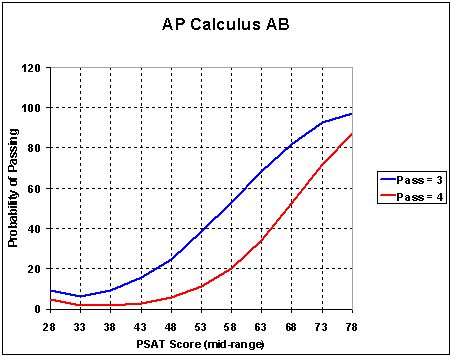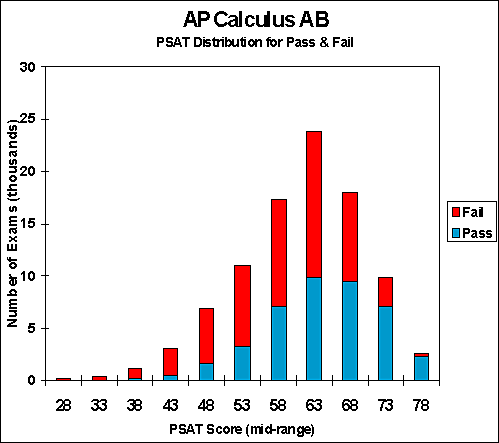Where Should We Go With Advanced Placement?
W. Lichten
Introduction
Self-evaluations of educational programs are not always
reliable. AP, a program which has a major impact on United States
high school curricula, lacks appraisal. AP targets have grown from
a small ivy-league elite to a much wider population. AP has not successfully
served this broader group. In the College Board's words, "AP
courses provide an opportunity for students to complete college?level
studies while still in secondary school and to receive advanced placement,
credit, or both, in col-lege..are intended for students who have...the
skills and motivation to complete college-level course work during
their high school studies...? Furthermore, ? There is a strong and
consistent relationship between PSAT/NMSQT scores and AP examination
grades...PSAT/NMSQT exams can also be very useful for high schools
in identifying... students who may be successful in AP..."
The College Board's 1-5 qualification scale, with 2 "possibly
qualified"and 3 "qualified" no longer holds, as many
colleges now require a 4. Figure 1 shows the PSAT-pass relation
for two AP scores, 3 and 4 in for the calculus AB test, widely taken
by students headed for calculus-based physics. Parenthetically, AP
has little direct effect on U.S. college physics. Algebra based Physics
B usually does not qualify. Calculus based Physics C qualifies, but
the numbers are small (ca. 15,000 for Mechanics and half as much
for Electricity and Magnetism). However, over 150,000 AP calculus
exams are taken annually, comparable to introductory calculus-based
physics enrollments. I have found that math background is the best
predictor of success in physics courses The average college-bound
student (PSAT ~ 50) has a poor chance of success for a passing grade
of 3 and even less for a score of 4. Until recently, "curving" (Lurie,
2000) concealed the AP scale's slide, which is linked to college
grade inflation.
|

Figure 1 |
|
The Equity-Excellence" Dilemma.
At first, only a few very able students took AP tests.
To widen AP access, the College Board admitted less skilled
persons, which lowered the success rate. The College Board
then had Hobson's choice: 1. meet college standards and preserve
excellence, or 2. curve the exam grades to encourage more participation
and equity. The first choice, undesirable for the College Board,
limits program size. The second choice, undesirable for colleges,
lowers quality. Figure 2 shows outcomes in the Calculus AB
exam. Practically all students with top PSAT scores, the group
AP originally served, qualify. For less able students, the
percentage yield of qualifying exams drops. The overall pass
rate is less than 50% (Lichten, 2000). The College Board plans
to double the number of exams by the year 2010. To do so, it
must recruit AP test takers largely from the vast middle and
bottom of the distribution. The failure rate would go even
higher. The value added by this expansion would be very low.
|
|

Figure 2 |
The Place of AP
Today AP is "standard" at highly selective
colleges (Russo, 2000), where practically everyone arrives with several
4s and 5s. But for most students with 1s, 2s, and 3s, the AP calculus
AB test serves for placement (standard vs. remedial) rather than
as advanced placement. Correspondingly, in some high schools there
are two tracks: advanced placement and remedial. In nonselective,
inner-city, predominantly minority high schools failure in AP is
the rule rather than the exception. In fact, it is not unusual in
such schools for the entire class to fail the AP exam, a heavy price
for increased access. ". . . a clever teacher sets a student's
work, and the expectations for it, at a level where some modicum
of legitimate success is possible... at an arm's length from the
student, but no further.". . . Theodore Sizer
A Feasible High School Curriculum
Three quarters of U.S. high school graduates enter
college, but many arrive unprepared. Nearly half take a remedial
course, one-third fail to make it into the sophomore class, and less
than half graduate. A major reason for this weak performance is the
high school curriculum.(Adelman, 1999). Adelman found that the best
graduation predictor is the highest level of math completed by the
student. The median high school graduate is between geometry and
algebra 2 (Table I column 2). Imagine raising the academic level
by moving each student up to the next math stage. According to Table
I, if students went from the pre-calculus level to calculus, the
gain in BA degrees awarded would be 0.3% of the graduates. A move
from algebra 2 to Trigonometry would increase graduation by 6.4%,
a twenty times larger effect. Less advanced programs than AP are
more likely to reach and benefit the bulk of high school students.
Table I. College outcomes for high school graduates
with varying degrees of math education to four-year colleges and
projected outcome upon raising the level of math education by one
rung on the ladder. Modified from Table 6 of Adelman (1999).
| Highest Math Studied in HS |
% of All HS Grads in This Group |
% of HS Grads in This Group Who Earn
BA |
Projected Gain in % BAs by Shifting
Group up 1 Rung |
| Calculus |
6.4 |
79.8 |
|
| Pre-calc |
5.9 |
74.3 |
0.3 |
| Trig |
11.3 |
62.2 |
1.4 |
| Algebra 2 |
28.3 |
39.5 |
6.4 |
| Geometry |
17 |
23.1 |
2.8 |
| Algebra 1 |
20 |
7.8 |
3.1 |
| Pre-Algebra |
11.1 |
2.3 |
0.6 |
Summary, Conclusions, Recommendations
AP is now standard college preparation that works for
gifted students. It does not work for average and below average students.
AP could better reach these students by introducing new tracks in
its program. AP has a faulty scale, and needs quality controls, outside
monitoring and policy guidance.
References
Adelman, C. (1999). Answers in the Toolbox. Washington:
U.S. Department of Education.
Lichten, W. (2000). Whither Advanced Placement? http://epaa.asu.edu/epaa/v8n29.html
Lurie, M. N. (2000). AP U.S. History: Beneficial or
Problematic? The History Teacher 33, No. 4, August. pp. 521-525.
Russo, F. (2000). Beyond Advanced Placement. http://www.villagevoice.com/issues/0015/russo.shtm
Text of an invited paper given by W. Lichten, Yale
University, New Haven CT 06520-8120, at the April Meeting of the
American Physical Society, Washington, DC, April 28-May 1, 2001,
in the session entitled Whither Advanced Placement?
W. Lichten is at the Institution for Social and
Policy Studies, Yale University
|